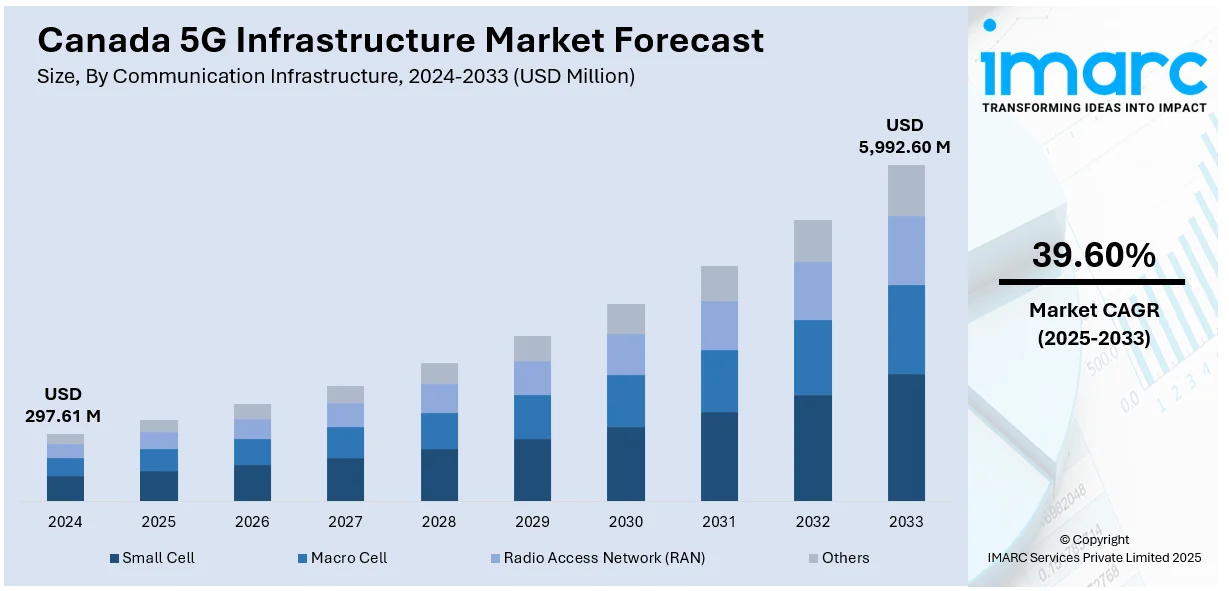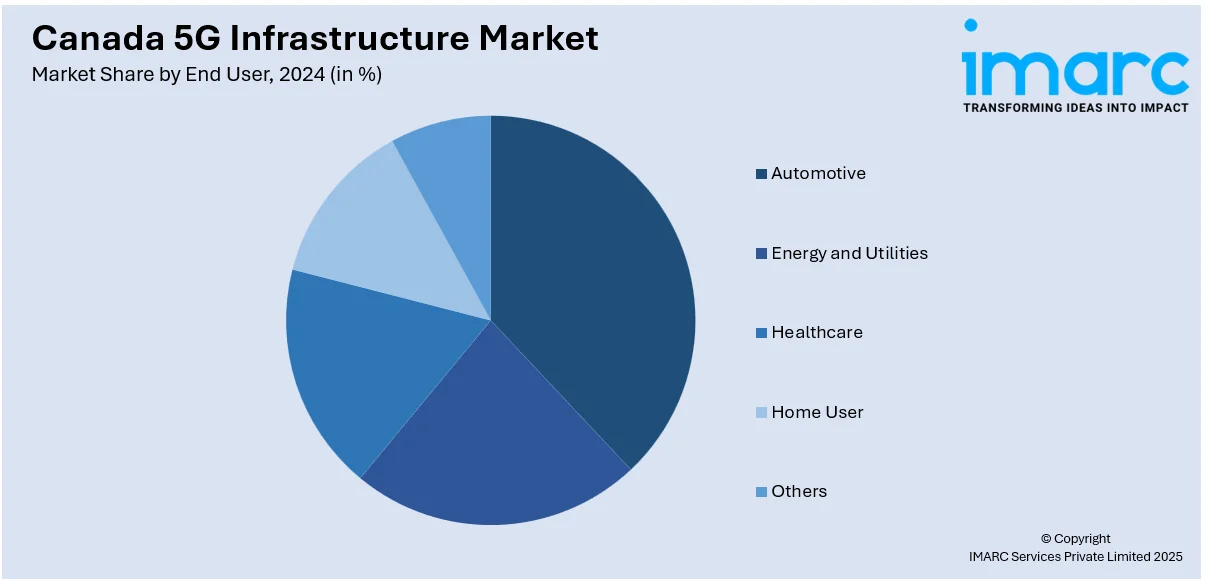
Canada 5G Infrastructure Market Size, Share, Trends and Forecast by Communication Infrastructure, Network Technology, Network Architecture, Frequency, End User, and Region, 2025-2033
Canada 5G Infrastructure Market Overview:
The Canada 5G infrastructure market size reached USD 297.61 Million in 2024. Looking forward, IMARC Group expects the market to reach USD 5,992.60 Million by 2033, exhibiting a growth rate (CAGR) of 39.60% during 2025-2033. The Canada 5G infrastructure market share is driven by the imposition of favorable government policies, rising demand for enhanced mobile connectivity, significant technological advancements, increasing proliferation of the Internet of Things (IoT) devices, and heightened collaborations between telecom operators and tech firms.
|
Report Attribute
|
Key Statistics
|
|---|---|
|
Base Year
|
2024
|
|
Forecast Years
|
2025-2033
|
|
Historical Years
|
2019-2024
|
| Market Size in 2024 | USD 297.61 Million |
| Market Forecast in 2033 | USD 5,992.60 Million |
| Market Growth Rate (2025-2033) | 39.60% |
Canada 5g Infrastructure Market Analysis:
- Major Market Drivers: The market is propelled by rising demand for low-latency, high-speed connectivity, government incentives, growing Internet of Things (IoT) adoption, and expanding cloud-based applications. These drivers are powering investments in cutting-edge 5G infrastructure to cope with the current data and connectivity needs, propelling Canada 5G infrastructure market growth.
- Key Market Trends: Adoption of emerging technologies such as edge computing, network slicing, and mmWave is gaining pace. The use of artificial intelligence (AI) and machine learning (ML) for optimizing the network and the growth of use for 5G in smart cities and industrial automation are the defining characteristics of the changing market scenario.
- Competitive Landscape: The market has dynamic involvement of telecom operators and tech companies rolling out countrywide 5G infrastructure. Operators concentrate on collaborations, technology advancements, and spectrum buying to improve service offering and achieve competitive advantage in the face of rising demand for dependable mobile connectivity.
- Challenges and Opportunities: High cost of deployment, delayed spectrum allocation, and rural connectivity gaps hamper growth. Opportunities lie in enterprise digitization, smart infrastructure growth, and government-sponsored initiatives of 5G adoption in verticals like healthcare, transportation, and manufacturing across cities and remote locations.
Canada 5G Infrastructure Market Trends:
Rising Government Support and Imposition of Regulatory Framework
The growing need for high-reliability and high-speed mobile connectivity, driving the demand for advanced 5G infrastructure, is positively influencing the Canada 5G infrastructure market. The rapid adoption of mobile internet for use cases such as video streaming, social media, and online gaming, requiring high bandwidth, and low latency is strengthening the market growth. Also, the increasing adoption of cloud services and remote working technology among firms is catalyzing the need for 5G networks to handle high-data capacity transmission with low latency, is stimulating the market growth. Apart from this, the rapid increase in the number of connected devices in the country including wearables, smartphones, and Internet of Things (IoT) devices, fueling the requirement for high-density network traffic infrastructure, is supporting the market growth in the country. This is contributing to the overall Canada 5G infrastructure market share.

To get more information on this market, Request Sample
Rapid Technological Advancements
The rapid development in technology across Canada, which are driven by hardware, software, and network architecture enhancements, are one of the primary driving forces behind the growth of the 5G infrastructure market. Moreover, increased adoption of advanced technologies by companies including network slicing, edge computing, and beamforming for enhancing the efficiency of 5G networks, is fueling the growth of the market. These advances enable higher data rates, ultra-reliable low-latency communication (URLLC), and massive machine-type communications (mMTC). Ongoing advancements in radio frequency technology such as millimeter waves (mmWave), to provide higher data rates and better utilization of spectrum are giving a very encouraging market climate. Besides, the rising adoption of ML and AI in 5G networks to optimize network performance and manage real-time traffic volumes is stimulating the market growth, as noted in recent Canada 5G infrastructure market analysis.
Increasing Demand for Enhanced Mobile Connectivity
The rising need for faster and more dependable cellular connectivity, resulting in the requirement for high-end 5G infrastructure, is favorably influencing the Canada 5G infrastructure market growth. The rise in mobile internet dependency for processes including video streaming, online gaming, and social media, that demand high bandwidth, and low latency is also stimulating the growth of the market. Moreover, the increasing uptake of cloud solutions and remote work solutions by companies, increasing the demand for 5G networks for managing large-scale data transmission with minimal latency, is offering lucrative growth opportunities to industry investors. The growing number devices connected in the nation such as wearables, smartphones, and Internet of Things (IoT) devices are creating the need for infrastructure capable of handling high-density network traffic, which is fostering market growth. These dynamics are aligned with key Canada 5G infrastructure market trends.
Canada 5G Infrastructure Market Segmentation:
IMARC Group provides an analysis of the key trends in each segment of the market, along with forecasts at the regional level for 2025-2033. Our report has categorized the market based on communication infrastructure, network technology, network architecture, frequency, and end user.
Communication Infrastructure Insights:
- Small Cell
- Macro Cell
- Radio Access Network (RAN)
- Others
The report has provided a detailed breakup and analysis of the market based on the communication infrastructure. This includes small cell, macro cell, radio access network (RAN), and others.
Network Technology Insights:
- Software-Defined Networking
- Network Function Virtualization
- Others
A detailed breakup and analysis of the market based on the network technology have also been provided in the report. This includes software-defined networking, network function virtualization, and others.
Network Architecture Insights:
- Standalone
- Non-Standalone
A detailed breakup and analysis of the market based on the network architecture have also been provided in the report. This includes standalone and non-standalone.
Frequency Insights:
- Sub-6 Ghz
- Above 6 Ghz
A detailed breakup and analysis of the market based on the frequency have also been provided in the report. This includes sub-6 Ghz and above 6 Ghz.
End User Insights:

- Automotive
- Energy and Utilities
- Healthcare
- Home User
- Others
A detailed breakup and analysis of the market based on the end user have also been provided in the report. This includes automotive, energy and utilities, healthcare, home user, and others.
Regional Insights:
- Ontario
- Quebec
- Alberta
- British Columbia
- Others
The report has also provided a comprehensive analysis of all the major regional markets, which include Ontario, Quebec, Alberta, British Columbia, and others.
Competitive Landscape:
The market research report has also provided a comprehensive analysis of the competitive landscape. Competitive analysis such as market structure, key player positioning, top winning strategies, competitive dashboard, and company evaluation quadrant has been covered in the report. Also, detailed profiles of all major companies have been provided.
Canada 5G Infrastructure Market News:
- In June 2025, Rogers Communications made Canada's first deployment of Ericsson's 5G Advanced technology go live, improving IoT and wearable device performance using RedCap software. This milestone solidifies the Canada 5G infrastructure market, enabling next-gen connectivity for businesses and consumers in over 2,500 communities throughout the country.
- In June 2025, Ericsson debuts its Indoor Fusion 8828, a 5G system designed in Canada that combines radio and baseband for richer indoor coverage in small places. Canadian carrier Bell becomes first worldwide adopter, enhancing its enterprise solutions and supporting Canada's 5G infrastructure leadership and deployment innovation.
Canada 5G Infrastructure Market Report Coverage:
| Report Features | Details |
|---|---|
| Base Year of the Analysis | 2024 |
| Historical Period | 2019-2024 |
| Forecast Period | 2025-2033 |
| Units | Million USD |
| Scope of the Report | Exploration of Historical Trends and Market Outlook, Industry Catalysts and Challenges, Segment-Wise Historical and Future Market Assessment:
|
| Communication Infrastructures Covered | Small Cell, Macro Cell, Radio Access Network (RAN), Others |
| Network Technologies Covered | Software-Defined Networking, Network Function Virtualization, Others |
| Network Architectures Covered | Standalone, Non-Standalone |
| Frequencies Covered | Sub-6 Ghz, Above 6 Ghz |
| End Users Covered | Automotive, Energy and Utilities, Healthcare, Home User, Others |
| Regions Covered | Ontario, Quebec, Alberta, British Columbia, Others |
| Customization Scope | 10% Free Customization |
| Post-Sale Analyst Support | 10-12 Weeks |
| Delivery Format | PDF and Excel through Email (We can also provide the editable version of the report in PPT/Word format on special request) |
Key Benefits for Stakeholders:
- IMARC’s industry report offers a comprehensive quantitative analysis of various market segments, historical and current market trends, market forecasts, and dynamics of the Canada 5G infrastructure market from 2019-2033.
- The research report provides the latest information on the market drivers, challenges, and opportunities in the Canada 5G infrastructure market.
- Porter's five forces analysis assist stakeholders in assessing the impact of new entrants, competitive rivalry, supplier power, buyer power, and the threat of substitution. It helps stakeholders to analyze the level of competition within the Canada 5G infrastructure industry and its attractiveness.
- Competitive landscape allows stakeholders to understand their competitive environment and provides an insight into the current positions of key players in the market.
Key Questions Answered in This Report
The 5g infrastructure market in Canada was valued at USD 297.61 Million in 2024.
The Canada 5g infrastructure market is projected to exhibit a (CAGR) of 39.60% during 2025-2033, reaching a value of USD 5,992.60 Million by 2033.
The market is driven by increasing need for high-speed, low-latency connectivity, increasing adoption of cloud computing and remote working technologies, high growth in IoT and connected devices, support and regulatory efforts from governments, ongoing development in network technologies like edge computing and millimeter wave deployment.
Need more help?
- Speak to our experienced analysts for insights on the current market scenarios.
- Include additional segments and countries to customize the report as per your requirement.
- Gain an unparalleled competitive advantage in your domain by understanding how to utilize the report and positively impacting your operations and revenue.
- For further assistance, please connect with our analysts.
 Request Customization
Request Customization
 Speak to an Analyst
Speak to an Analyst
 Request Brochure
Request Brochure
 Inquire Before Buying
Inquire Before Buying




.webp)




.webp)












